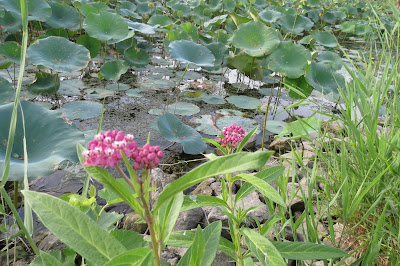 |
| A young Bald Eagle circles over head with a full white-headed adult. |
Today's surprise was found overhead. Two Bald Eagles circled above and conducted a series of dives and aerial flip flops. The recovery story of Bald Eagles on our North Coast never ceases to make me smile. How lucky are we to see these magnificent birds high in our skies!
 |
| Red-Spotted Purple butterfly |
 |
| Under wing of Red-spotted Purple |
 |
| Hackberry Emperor, |
One of my favorite trees at Meadowbrook is the Northern Hackberry. But why am I talking trees when this obviously a butterfly photo? The Hackberry tree is the ONLY host plant for the Hackberry Emperor. Three types of butterflies feed on Hackberry in their larva stage: Tawney Emperor, Hackberry Emperor, and the American Snout. This particular Emperor was resting on a Common Milkweed plant.
Milkweed does not play a role in the life cycle of the Tawney Emperor, but it is the host plant of the Monarch butterfly. When you think of butterflies- remember it is not just the Monarch at needs a host plant to survive. Hackberry trees are important, too.
 |
| Wetland species Swamp Milkweed and American Lotus |
Meadowbrook is known for its marsh and Swamp Milkweed is right at home in a marsh. These beautiful pink flowers are perfect for young Monarch butterfly larva. Just beyond the water edge, those large circular leaves belong to the American Lotus. One of our most beautiful native aquatic plants is just finishing its bloom cycle. (To see more on American Lotus http://aquaplant.tamu.edu/plant-identification/alphabetical-index/american-lotus/)
 |
| American Lotus seed head. |
Come on out to Flora-Quest 2016 and you can choose your own trip to see aquatic specialties in the marshes and wetlands on the North Coast.
Registration has been extended to Sept. 15, 2016. Sign up now for an eco-tourism adventure!
